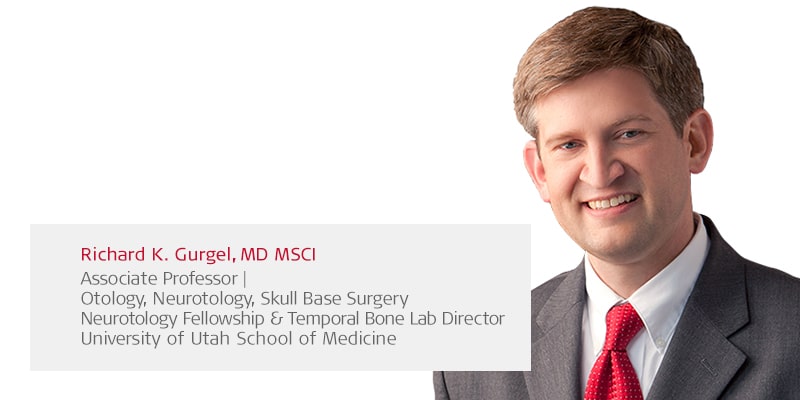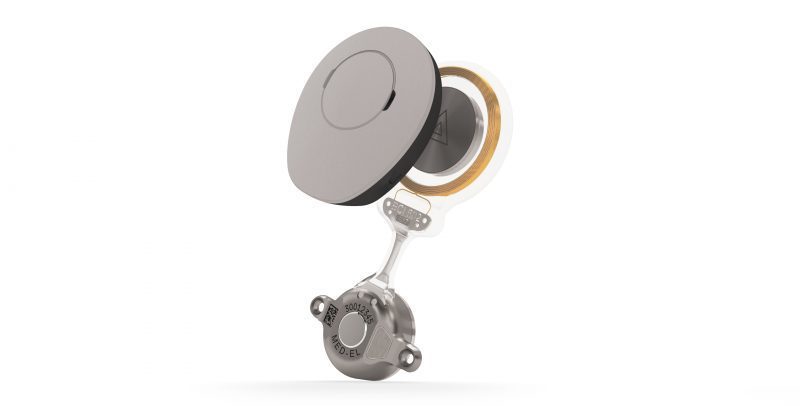MED-EL
Published May 04, 2021
BONEBRIDGE BCI 602: Surgical Experience With Dr. Richard Gurgel

Today we are excited to present first-hand surgical experience on BONEBRIDGE BCI 602 from Dr. Richard Gurgel.
BONEBRIDGE is our active bone conduction implant for conductive hearing loss, mixed hearing loss, and single-sided deafness. The second generation, BONEBRIDGE BCI 602, was introduced in 2019 and offers improved surgical handling, robust fixation, and the proven reliability of the BONEBRIDGE system.
Dr. Gurgel is a Neurotologist at the University of Utah, which is a center that specializes in hearing implants. Dr. Gurgel did his residency training at the University of Iowa, and his fellowship at Stanford University, and has extensive experience in both cochlear implants and bone conduction implants.
In addition to performing hearing implant surgery, Dr. Gurgel’s main research emphasis is focusing on the effects of hearing loss in older adults. He currently has an NIH R21 grant to study whether cochlear implants mitigate the risk of Alzheimer’s disease in older adults. They are using the Utah Population Database, a unique, multigenerational database in Utah, to answer the question.
Let’s turn over now to Dr. Gurgel to hear his first-hand experience with the new BONEBRIDGE BCI 602.
A Surgeon’s Perspective: Bone Conduction Implants
At the University of Utah, we do approximately 150 cochlear implant surgeries per year across all of our sites in children and adults, and many bone conduction devices. I have been in the field of hearing implants for almost 11 years, and have been doing bone conduction implants throughout that time.
The two main indications for bone conduction implants (BCI) are:
- Single-sided deafness in which the BCI conducts to the contralateral, better-hearing ear. Now that MED-EL has received FDA approval for cochlear implants for single-sided deafness, we may be seeing more patients who would have been BCI candidates now getting cochlear implants.
- Conductive hearing loss in which there is no other surgical means to restore conductive hearing and a traditional hearing aid is contraindicated. Patients who are indicated for conductive hearing loss often have severe chronic ear disease with atelectasis and no middle ear space for ossiculoplasty and who drain from the ear when using a traditional hearing aid. I think the potential is there for more widespread use of BCI.
Percutaneous implants work well for sound conduction and hearing, but there are disadvantages. The percutaneous posts cause a chronically open wound for patients. Many patients do fine with this, and skin will grow to the percutaneous abutment, but others (30% or more) will have soft tissue problems such as crusting, granulation (inflammatory) tissue, or skin overgrowth around the abutment. For some patients, the cosmetic aspect of having a visible, percutaneous post was also a deterrent.
Transcutaneous implants were meant to be a boon in the area of osseointegrated devices and a replacement of percutaneous implants. Unfortunately, if the active processor is external to the skin (i.e. passive transcutaneous implants), there is attenuation or a dampening effect of the volume of sound. Moreover, I’ve had some patients who have had skin irritation due to heavy external processors of passive implants.
Active BCI implants, in which the sound is generated by an internally-placed device, are much more effective for dynamic range and intensity of sound. The hearing outcomes for BONEBRIDGE BCI 602 have been outstanding. Patients are very happy with the sound level and quality. Patients reach satisfactory hearing levels very soon after activation.
 The BONEBRIDGE BCI 602 Active Bone Conduction Implant with SAMBA 2 Audio Processor. The implant is placed fully under the skin, and the audio processor is held in place by gentle magnetic attraction.
The BONEBRIDGE BCI 602 Active Bone Conduction Implant with SAMBA 2 Audio Processor. The implant is placed fully under the skin, and the audio processor is held in place by gentle magnetic attraction.
Surgical Experience: BONEBRIDGE Active Bone Conduction Implant
For patients who meet BCI criteria, I will explain all options for aural rehabilitation. Patient preference plays a large role. For older patients who may need to use a hearing aid on the contralateral side, I may recommend non-surgical options such as (bi)CROS hearing aids. The patient has to be a good surgical candidate with enough bone to accept a BCI, which will be most patients.
The first generation of BONEBRIDGE (BCI 601) worked great. Patients were very happy with it, and the hearing outcomes were excellent. The main drawback of the initial design was the depth of the barrel of 9mm. If the device was placed above the temporal line or behind the sigmoid, a surgeon would often have to drill down to dura, compress the dura, use lifts, or all of the above. The second generation of BONEBRIDGE (BCI 602) with only a 4mm depth is much easier to place.
The improvements in BCI 602 were fantastic and notably improved over the first generation. The design and handling of this implant is much better than the first generation. I would like to see continued downsizing of the internal processor as well as expanded FDA indications to lower the lower age limit. The BCI 602 would be a great option for patients with congenital aural atresia, and it would be nice to offer this to them at an age lower than is currently approved.
Once a patient meets surgical criteria and would like to move forward, I will order and analyze their CT scan to find the ideal location. I look for areas that are naturally flat and that have adequate bone depth. I try to identify external landmarks that will help me identify the ideal location during surgery.
I talk with the patients about where they would like the coil and where they plan to wear the external processor. I try to match the location with the patient’s wishes. In general, soft tissue thickness increases the lower on the scalp you go, so I try to be mindful of an ideal height so that the skin flap thickness will accommodate the magnetic coupling.
The flexibility of the BCI 602 is excellent and important so that a surgeon can account for difference in patient anatomy. The flexibility definitely helps in accommodating implant placement, and I am generally able to place the transducer where I would like to.
I then follow the surgical steps as outlined by MED-EL. Drilling the edges of the well such that they are effectively straight and 90 degrees, rather than being rounded and saucerized, is important. The well always needs to be bigger and deeper than I initially think it will need to be. I find the sizer to be very helpful, and I don’t try to place the actual device until the sizer fits perfectly.
Dr. Richard Gurgel demonstrates his technique for implanting the BONEBRIDGE BCI 602. This second generation BONEBRIDGE is designed for improved surgical handling and straightforward surgery. This video also appears in the upcoming publication Otology Surgery, 5th edition. Brackmann, Shelton, Arriaga, & Gurgel, and is used with permission from Elsevier.
Can’t See This Video?
Having problems viewing this video? Watch it on YouTube.
The amount of drilling is a reasonable amount for depth and volume, and is a big improvement over the first generation. That said, to gain even more widespread acceptance and use from all surgeons, including comprehensive or general otolaryngologists, I would like to see the transducer become even lower profile – a smaller diameter and shorter depth.
The implant toolkit is great. It is nice to have everything packaged together, and self-drilling screws are always preferred to screws that require a separate tapping instrument. The BCI 602 is very secure when it is flush with bone and inserted according to manufacturer’s recommendations. I feel confident about the long-term security and robustness of the implant.
Looking Beyond Surgical Factors
MRI compatibility is very important for BC implants. Many of our single-sided deafness patients have undergone surgery for vestibular schwannoma removal. Those patients need serial surveillance imaging with MRI. Moreover, the percentage of all individuals who need an MRI at some point in life is very high, and MRI compatibility is very important. The BONEBRIDGE does have a large image artifact on brain MRIs, but those can often be angled in such a way as to get an adequate image of the cerebellopontine angle.
The BONEBRIDGE is very comfortable for patients to wear, even when living in different weather or work environments. I had a young patient who had profound hearing loss following a vestibular schwannoma removal. She underwent a BONEBRIDGE procedure, and shortly thereafter, left to do humanitarian work in a tropical environment in Southeast Asia. She had no trouble with her device, and it was a great help to her in communicating and doing her work.
Thank you for sharing your perspective Dr. Gurgel!
Subscribe & Share
Ready to learn more about BONEBRIDGE? Check out this great overview post on all the new features.
Don’t forget to subscribe to get all the latest updates from the MED-EL Professionals Blog.
*The BONEBRIDGE BCI 602 Active Bone Conduction Implant is MR conditional. Recipients with BONEBRIDGE BCI 602 may be safely MRI scanned at 1.5 Tesla following the conditions detailed in the instructions for use.
MED-EL
Was this article helpful?
Thanks for your feedback.
Sign up for newsletter below for more.
Thanks for your feedback.
Please leave your message below.
CTA Form Success Message
Send us a message
Field is required
John Doe
Field is required
name@mail.com
Field is required
What do you think?
The content on this website is for general informational purposes only and should not be taken as medical advice. Please contact your doctor or hearing specialist to learn what type of hearing solution is suitable for your specific needs. Not all products, features, or indications shown are approved in all countries.
MED-EL



